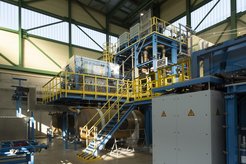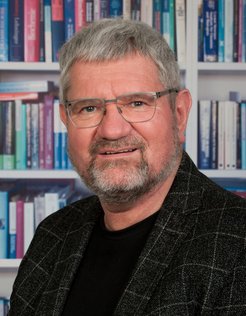“We need a world trade in renewable energy”
Max Planck Director Robert Schlögl in an interview about green hydrogen and sustainable CO2 recycling
The flood disaster in Germany, the extreme heat waves, the forest fires in parts of southern Europe, and not least the latest report of the Intergovernmental Panel on Climate Change make it clear that we must quickly and drastically reduce our CO2 emissions. This will require a considerable amount of electricity from renewable sources – also for the production of hydrogen through the electrolysis of water. Many sectors of the economy rely on green hydrogen for their climate-friendly conversion. This means that even CO2, which cannot be avoided, can be converted into methanol as a fuel and basic material for the chemical industry. In technical jargon, this is known as carbon capture and use (CCU). We spoke with Robert Schlögl, Director at the Max Planck Institute for Chemical Energy Conversion in Mülheim an der Ruhr and at the Fritz Haber Institute of the Max Planck Society in Berlin, about where the hydrogen for the upcoming transformation can come from and how useful CCU technologies are. Topics also included the areas of the economy in which there is particularly great potential for reducing CO2 and what contributions science can make to the necessary change in the economy and society.

Prof. Schlögl, we cannot cover even the current electricity demand with wind power and photovoltaics. Where will all the renewable energy and green hydrogen for the climate-friendly transformation of the economy come from?
A large part of the renewable electricity and hydrogen will be generated not in Germany but rather in countries where there is more wind and sun. There might be a shortage of water, especially because electrolysis with seawater is not technically feasible. The desalination of seawater would consume a small part of the energy generated. But in Germany and Europe, we cannot produce the quantities of hydrogen we need.
Replacing fossil fuels with hydrogen would make many products more expensive. How can companies that convert to climate-friendly production remain competitive?
If we do this only in Germany, that is, of course, a problem. But no one in the world can ignore the reports of the Intergovernmental Panel on Climate Change and the obvious signs of climate change. That’s why we urgently need a world trade for renewable energies – just as there is today for fossil raw materials. The energy price would then be regulated by the market economy – and everyone would pay the same price.
How would we organize the global trade in electricity from renewable sources and green hydrogen in terms of logistics? Would power lines be laid from the countries with a lot of wind and sun? Or would chemical energy sources be used for transport?

For many applications, chemical energy sources make more sense because the energy is stored in them and can be used when needed. We can also build on existing infrastructure. In Europe, hydrogen could be transported through the existing pipeline network. For transport outside Europe, we could, for example, produce methanol from hydrogen and CO2. This could then be shipped across the oceans in tankers. How we can build up an efficient hydrogen infrastructure is the subject of a project called TransHyde, which my group is also involved in. This project is funded by the Federal Ministry of Education and Research to the tune of €139 million. In addition to methanol, liquid organic hydrogen carriers (LOHC) or carriers in the form of ammonia, play a role. Saudi Arabia works with ammonia carriers. From this, either fertilizer or nitrogen and hydrogen can be produced. We are currently investigating how the carriers can be split within the framework of TransHyde. It is important that we introduce a certification for hydrogen so that nobody is cheated. Anyone can claim that hydrogen is green or blue when in reality it is black.
Blue hydrogen is produced from natural gas. But the CO2 that is produced is stored in natural gas reservoirs, for example. How can green and blue hydrogen be distinguished from black hydrogen – in other words, hydrogen conventionally produced from natural gas?
Hydrogen from natural gas still contains long-chain hydrocarbons, which are easy to detect.
In the Carbon2Chem project, thyssenkrupp AG and others are looking into how CO2 from steelworks – as well as cement production or waste incineration plants – can be converted with hydrogen into methanol, for example. Will hydrogen be cheap enough to justify the costs?
Hydrogen will eventually become cheaper. In recent years, a lot has already happened in terms of efficiency. An important factor now is the cost of the electrolysers. They are currently three times more expensive than they would have to be in order to compete with coal power. However, they are currently also produced using manufactory technology – and not contemporary production technology. General Electric has now taken the important step of building a production line for electrolysers.
Nevertheless, many products are likely to become more expensive if they are produced with the help of renewable resources instead of fossil raw materials. Will we still be able to afford such products?
Energy accounts for 3% of the global economy. The burden should therefore not be too great. And when energy becomes more expensive, it is of course also sensible to ask whether you still need a certain product.
With CCU techniques, it is not only the costs that are decisive. If the CO2 from steel production is turned into fuel or other chemical products, it still ends up in the atmosphere sooner or later. Is it enough if we want to be climate-neutral by 2045 – as the German government has set out?
We will have halved CO2 emissions. And for aircraft, we will need synthetic fuels like methanol. I consider the CO2 that results from this to be almost negligible. I also don’t believe that we can operate in a completely climate-neutral way. We would need compensatory measures for this. We either have to plant trees – although this only postpones the problem for the future, when all areas have been afforested and there is a balance between new and dying trees. Or the CO2 can be filtered out of the air with Direct Air Capture. But removing 400 ppm from water vapour is an arduous task.
The transition to a climate-friendly economy is a matter not only for industry. Beyond that, where do you see the biggest levers?
A considerable amount of CO2 is produced in coal-fired power plants, transport, and intensive agriculture. But above all, it would be a great help if we built equipment and buildings that do not have to be constantly discarded or demolished. Buildings, in particular, contain a great deal of CO2. This also affects us as a research organization. We should build only in a climate-neutral way. So far, however, there have also been obstacles in terms of public funding law. We should build in such a way that laboratories, for example, can be used in a variety of ways and are not rebuilt every time the research focus changes.
As a science organization, the Max Planck Society can also contribute to combating climate change through its research. Where do you see the most important tasks?
There is still a need for research in many places. In my own field, I think it is possible to eliminate 50% of the losses from chemical production if we improve catalytic processes. In materials science, we need to find an alternative for cement. In general, we need to consider sustainability much more in the use and design of materials. Why use sheet metal when foil will suffice? And there is still infinite potential in the material recycling of metals and plastics. How materials can be reused must therefore be considered as they are developed. There is also still considerable need for research in the system analysis of energy supply.
What is it all about?
Models that can be used to analyse where power plants should be built, where electricity and energy sources should be brought, and where new pipelines should be laid. The energy system – like the climate – is highly dynamic. And there are many interactions.
Humans are probably the most important factor in the shift towards a climate-friendly society. We need to change our behaviour. Can science provide insights into how to bring about such behavioural change?
Of course, energy is made by humans for humans. And humans intervene massively in the cycles of life. We, as humans, must therefore participate in the transformation processes. Models could also help us to better understand the system of climate, energy, and society. For this, we must bring together not only different disciplines such as the natural sciences and the social sciences, which, until now, have been arbitrarily separated. This is infinitely complex and costly. If we take this on, we also have to abandon the common approach to basic research of seeking to make models as simple as possible. Such models then have little to do with real conditions. We must therefore take into account the full complexity of such systems if we want to arrive at practical, usable results. This would also be a major task for the Max Planck Society
Interview by Peter Hergersberg













